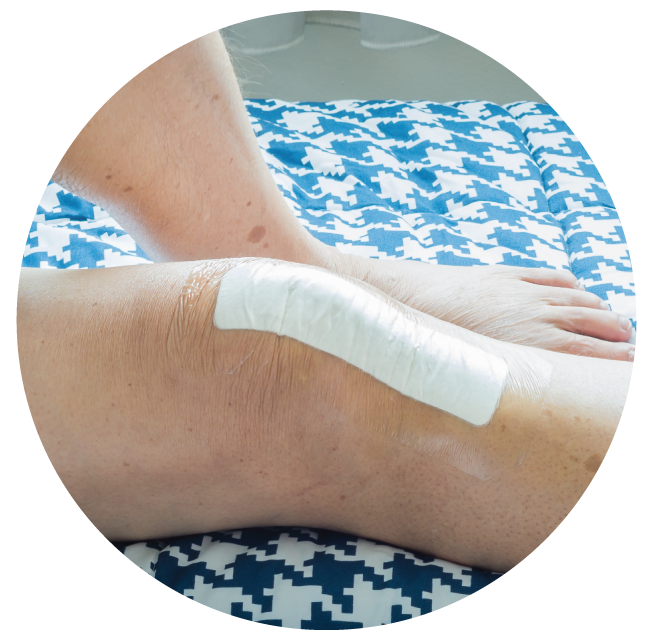
FAST FACTS: Heat Therapy
Heat relieves pain by:1) improving circulation to skin and muscles, 2) relaxing muscles and reducing muscle spasms and irritation, and 3) decreasing sensitivity to pain. Heat treatments are placed at or near the site of the pain.

Heat Treatment Options:
- Moist compress
- Instant heat pack
- Portable hot water therapy pump
- Adhesive warming patch
- Gel/clay pack
Heat Application Guidelines:
- DON’T:
- Do not use heat if it increases the pain
- Do not use on areas being treated by radiation or open wounds.
- Do not put boiling water in a hot water bottle or on a washcloth; water temperature should be between 104- and 113-degrees Fahrenheit
- Do not apply heat directly over a transdermal medication patch
- Do not use heat on a recent injury (for example, a sprained ankle) as it may increase inflammation or bleeding in area
- Do not use a heat lamp
- NEVER USE PRODUCTS CONTAINING MENTHOL WHEN USING HEAT
- These products cause skin to absorb heat more deeply and might cause burns (examples: Icy Hot or Ben-Gay)
- DO:
- Regularly check skin for irritation or burns and document in your loved one’s Pain Diary
- Think WARM, not HOT. Keep a single layer of material between heat source and skin
- Use moist heat as it increases the effect of heat
- Apply heat on the area for 20 to 30 minutes every 2 hours
- CAREFUL USE:
- If you have damage to the nerves in your hands and/or feet, use caution in those areas where there is an impaired ability to feel
- If you have thin/fragile skin, consult your healthcare team on use of heat
- If using a heating pad, only use on the lowest setting and while you are awake
- Don’t use heating pad or heated gel pad directly on skin, wrap in towel before application
Directions
- Flax seed or clay/gel compress can be microwaved, follow manufacturer’s instructions.
- If using a towel, place it in warm water, or a moist towel can be placed in a towel warmer.
- Check the temperatures of the moist towel or compress; temperature should be between 104- and 113-degrees Fahrenheit.
- Wrap a warm moist towel around the warmed compress
- Apply to the painful area and secure loosely with an elastic wrap
- Keep the towel/compress on the area for as long as possible to obtain relief, but no more than 20 minutes at a time. Check skin for redness/irritation after removing compress.
- Re-warm when towel or compress is no longer warm. Check temperature each time the compress is reapplied.
- Try alternating hot and cold to improve comfort. Find correct area or temperature that provides optimal pain relief. See Fast Fact on Cold for more details (add link here)
Notes for Patient
- Before using heat, speak with your healthcare provider to determine the correct technique. They will be able to tell you where to find additional training if needed.
- Ask a family member or friend to help as needed with applying heat. You may need help to prepare/apply the warm compress or ace wrap, and time the application of heat.
What Else You Should Do
- Write down and share information about your pain with your healthcare provider
- Use a Pain Diary to note important information useful to the healthcare provider
- Try a non-drug treatment and document the impact on pain in your Pain Diary
References
- Adapted from: Fouladbakhsh, J.M., et al., Nondrug therapies for pain management among rural older adults. Pain Manag Nurs, 2011. 12(2): p. 70-81. 2. The Nursing Home Pain Management Algorithm Clinical Trial, R01 NR009100, 7/1/05 – 4/30/10; Mary Ersek (PI) Used with permission of Mary Ersek and HPNA (2009).
- WedMD. 2021. When Should I Use Heat or Ice for Pain? Accessed 2.21.2022, https://www.webmd.com/pain-management/when-use-heat-ice
- Health Essentials, Cleveland Clinic; December 8, 2020. Here’s How to Choose Between Using Ice or Health for Pain. Accessed 2.21.2022. https://health.clevelandclinic.org/should-you-use-ice-or-heat-for-pain-infographic/
Revised January 2022
